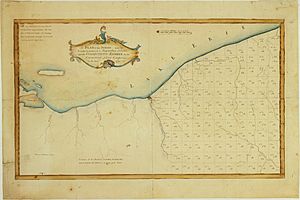Connecticut Land Company facts for kids
The Connecticut Land Company was a group of people who bought and sold land in the late 1700s. They started in 1795, right after the American Revolutionary War. Their goal was to explore and help people settle in a new area called the Connecticut Western Reserve. This land was in what is now Ohio.
After the Revolutionary War, different states argued over who owned land in the west. The new United States government helped settle these arguments. States like Connecticut gave up most of their claims. But they kept a special part, which became the Connecticut Western Reserve. This area is in Northeast Ohio, and the city of Cleveland is at its center.
In 1795, the Connecticut Land Company bought three million acres of this land. That's about 12,000 square kilometers! They followed rules from the Land Ordinance of 1785. These rules said that land had to be measured before it could be settled. So, in 1796, the company began surveying the land and selling it.
Contents
How the Company Started
The Connecticut Land Company was created by a group of wealthy men from Connecticut in 1795. They wanted to make money by selling land. They bought a large part of the land that Connecticut still owned in the west.
The company paid the state of Connecticut $1.2 million for three million acres. This money was used by Connecticut to improve its public schools. This helped many students get a better education. The land bought by the company was then divided into 1.2 million shares. Each person or group who invested money got a share of the land.
Selling the Land
The main goal of the Connecticut Land Company was to earn money. They planned to sell the land to people who wanted to move there. They also sold land to other investors who hoped to sell it again for a higher price.
Sometimes, land was sold many times before someone actually moved onto it. The company faced challenges in selling the land. They had to lower prices and even give away some land for free. This was done to encourage more people to settle in the area. These problems eventually led to the company having financial difficulties.
Important People in the Company
The company was owned by 35 different groups. These groups included 58 individual investors.
- Oliver Phelps was the leader of the Connecticut Land Company. He invested the most money in the company. He was also in charge of managing the whole project.
- Moses Cleaveland was another important person. He was one of the company's first directors. In 1796, he led the first survey of the Western Reserve. He also made a deal with the Iroquois people. They agreed to give up their land claims east of the Cuyahoga River. Moses Cleaveland also started a settlement that was named after him. This settlement later became the city of Cleveland. The name changed slightly because of a map-making mistake.
Challenges the Company Faced
The Connecticut Land Company ran into several problems. These issues made it hard for them to succeed.
Poor Management
One big problem was how the company was managed. They didn't have a good plan for selling the land. There was no main office in the Western Reserve to help promote sales. Because of this lack of organization, their efforts to sell land were not very successful. By the year 1800, only about 1,000 people had moved to the region.
Political Confusion
Another issue that hurt land sales was political uncertainty. People were unsure about who had the right to govern the land. There were arguments between the Northwest Territory and the state of Connecticut. Both claimed the right to control the land the company had bought.
Also, the company wanted Connecticut to promise that the land titles they gave out were legal. But Connecticut refused to do this. Because of this confusion about who owned the land and who governed it, many people decided not to move there.
Lack of Protection
To make things even less appealing, the U.S. government did not officially recognize the Western Reserve as part of the Northwest Territory until 1800. This meant that settlers in the area did not have legal or military protection from the U.S. government.
However, on April 28, 1800, President John Adams signed the Quieting Act. This law confirmed Connecticut's right to govern the land. It also guaranteed that the land titles given by the Connecticut Land Company were legal. This act was supposed to encourage more people to settle and develop the region. Even with this new law, the company's poor management continued. So, not many new settlers arrived. The area didn't really grow much until after the War of 1812.
Company's End
Because of low land sales and ongoing problems, the Connecticut Land Company never made enough money. In 1809, just 14 years after it started, the company went bankrupt. This means it ran out of money and had to close down.
All the land that was left was divided among the company's investors. At that time, the company still owed a lot of money and couldn't pay its debts.


